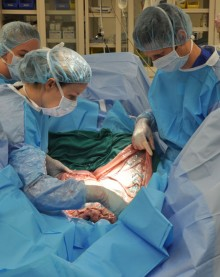CALEC surgery, or cultivated autologous limbal epithelial cell therapy, signifies a groundbreaking advancement in eye damage treatment, offering renewed hope for patients with corneal injuries. This innovative procedure involves harvesting limbal epithelial cells from a healthy eye, cultivating them, and then transplanting these vital cells to repair a damaged cornea. By utilizing corneal stem cell treatment, CALEC not only restores the cornea’s surface but also alleviates the persistent pain and visual impairments traditionally associated with corneal damage. In trials, this stem cell therapy for eyes has demonstrated an impressive success rate, effectively reversing conditions previously deemed untreatable. As the medical community delves deeper into eye repair technologies, CALEC surgery emerges as a promising solution for restoring vision and enhancing the quality of life for those affected by severe eye injuries.
Cultivated autologous limbal epithelial cells (CALEC) therapy represents an exciting leap in ocular regeneration, revolutionizing how we address severe eye injuries. This cutting-edge approach harnesses the power of stem cells from the limbal region of the eye, crucial for maintaining its integrity and visual function. By restoring these essential cellular components, clinicians can significantly improve outcomes for individuals suffering from cornea disorders and other related complications. As research advances in corneal regeneration techniques, alternatives such as CALEC surgery signify a pivotal shift towards effective treatments that were once considered unattainable. Ultimately, the focus on limbal epithelial cells and their regenerative potential paves the way for innovative strategies to combat various forms of eye damage.
Understanding CALEC Surgery: A Revolutionary Solution for Corneal Damage
CALEC surgery, or Cultivated Autologous Limbal Epithelial Cells surgery, represents a groundbreaking advance in the field of ocular surface reconstruction. In this innovative procedure, stem cells are harvested from a patient’s healthy eye and cultivated to create a graft, which is then transplanted into a damaged eye. This targeted approach not only utilizes the patient’s own cells but also leverages the unique regenerative properties of limbal epithelial cells to repair the corneal surface, thus offering new hope for individuals suffering from severe eye damage.
The success of CALEC surgery is rooted in its ability to restore the vision of patients who have sustained debilitating injuries to their corneas. These injuries often prevent the possibility of traditional corneal transplants. By focusing on regenerating limbal epithelial cells through careful surgical manipulation and advanced cell manufacturing techniques, CALEC surgery has achieved a remarkable success rate of over 90% in restoring corneal function, as reported in the recent clinical trial.
Frequently Asked Questions
What is CALEC surgery and how does it work?
CALEC surgery, or cultivated autologous limbal epithelial cells surgery, is a groundbreaking stem cell therapy designed to repair damage to the cornea. The procedure involves taking healthy limbal epithelial cells from a patient’s unaffected eye, expanding them in a specialized manufacturing process, and then transplanting them into the damaged eye, effectively restoring the corneal surface.
What conditions can CALEC surgery treat?
CALEC surgery is primarily used to treat severe corneal injuries that result from conditions such as chemical burns, infections, or trauma leading to limbal stem cell deficiency. This innovative eye damage treatment aims to rehabilitate the cornea, which traditional therapies may not effectively address.
How effective is CALEC surgery in restoring the cornea?
The clinical trial for CALEC surgery indicated a success rate of over 90% in restoring the cornea’s surface. Complete restoration was observed in approximately 50% of participants by three months, increasing to around 79% and 77% at 12 and 18 months, respectively, showcasing the efficacy of this stem cell therapy for eyes.
Is CALEC surgery safe for patients?
Yes, CALEC surgery has demonstrated a high safety profile in clinical trials, with no serious adverse events reported in either the donor or recipient eyes. While minor adverse events occurred, they were resolved quickly. This indicates a promising safety aspect of the stem cell treatment for corneal repair.
What are limbal epithelial cells, and why are they important in CALEC surgery?
Limbal epithelial cells are specialized stem cells located in the limbus of the eye, crucial for maintaining the smooth surface and integrity of the cornea. In CALEC surgery, these cells are harvested and expanded to create a graft, which is essential for successfully repairing corneal damage.
Can CALEC surgery be performed on patients with damage to both eyes?
Currently, CALEC surgery can only be performed on patients who have one healthy eye. However, researchers are exploring an allogeneic approach to using stem cells from cadaveric donor eyes, which may allow treatment for patients with bilateral corneal damage in the future.
When will CALEC surgery be available for more patients?
As of now, CALEC surgery remains experimental and is not widely available. More trials are needed to gather additional data and move toward FDA approval. Future studies aim to include larger patient groups and longer follow-ups to establish the treatment’s broader accessibility.
What are the next steps for CALEC surgery after clinical trials?
After the successful completion of initial clinical trials, the next steps for CALEC surgery involve conducting larger-scale studies to ensure efficacy and safety across diverse populations, cumulative data collection, and ultimately seeking FDA approval to make the treatment widely available.
| Key Point | Details |
|---|---|
| Procedure Origin | CALEC surgery was developed at Mass Eye and Ear. |
| Clinical Trial Results | The trial demonstrated a success rate of over 90% in restoring the cornea’s surface. |
| Method | Involves harvesting stem cells from a healthy eye and transplanting them into a damaged eye. |
| Safety Profile | High safety profile with no serious adverse events reported. |
| Potential Expansion | Future plans include using stem cells from donor eyes to treat patients with damage to both eyes. |
| Ongoing Research | Further trials are planned to facilitate FDA approval. |
Summary
CALEC surgery marks a revolutionary advancement in the treatment of corneal injuries that were previously deemed untreatable. Initiated by clinical trials at Mass Eye and Ear, this innovative procedure has shown tremendous promise, with over 90% effectiveness reported in restoring corneal surfaces. As ongoing research and trials continue, CALEC surgery may soon become a viable option for patients suffering from corneal damage, providing new hope and improving quality of life for many.










